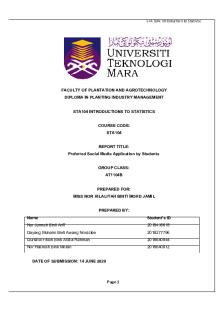Tina Tompkins Written Report 4 CRJ545 PDF

| Title | Tina Tompkins Written Report 4 CRJ545 |
|---|---|
| Author | Tina Tompkins |
| Course | Introduction to Forensic Science |
| Institution | Saint Leo University |
| Pages | 8 |
| File Size | 66.4 KB |
| File Type | |
| Total Downloads | 93 |
| Total Views | 127 |
Summary
Week 4 written report...
Description
Running head: DNA
1
DNA Evidence Tina Tompkins CRJ-545
DNA
DNA
Abstract Evidence is such an important aspect of forensics and criminal investigations. Crime scene investigators must take special precautions to make sure that evidence is not contaminated or destroyed before it is able to be analyzed. Many pieces of evidence can help investigators identify the individual responsible for the crime. Hairs, fibers and fingerprints can all assist investigators fully investigate the crime that occurred. DNA is no exception, it can be used to help identify not only the suspect but also the victim if they are otherwise not identifiable. DNA has also been able to exonerate those who have been wrongly accused of a crime by proving that they are not the ones who left the evidence behind. Without DNA, many more victims could remain unidentified, suspects could be free to commit more crimes and those that are innocent may still be serving time for the crimes they did not commit.
DNA DNA Evidence Arguably the most important aspect of any criminal or forensic investigation is evidence. Evidence allows investigators to paint a picture of what occurred during the time of the criminal act, identify the victim and even prove or disprove someone committed the crime. Without evidence, it may be impossible to piece together a crime or identify and convict a suspect, leaving many families without justice for a crime committed against their loved ones. There are many types of evidence that investigators can process and interpret to properly complete a criminal investigation. Forensic evidence can come in all shapes and sizes, making it important for crime scene investigators to never disqualify evidence even if they think that it may not be of importance because it is miniscule or seems to not be related. This evidence can sometimes be what leads to a criminal conviction in a later trial and without it, many criminals may remain free to commit more crimes in the future and possibly take more lives of potential victims. Potentially one of the most popular pieces of evidence and one that is especially popularly portrayed in television shows is DNA evidence. DNA evidence can come in many forms and can prove to be helpful in many ways during criminal investigations. DNA, or deoxyribonucleic acid, is the hereditary material in humans and almost every cell in a person’s body contains the same DNA makeup (NIH, 2020). DNA is very complex and is unique to individuals and this uniqueness makes it a very powerful tool for forensic investigations. A person’s DNA is made up of chemical bases of adenine, guanine, cytosine, and thymine (NIH, 2020). DNA is helpful in many ways, including identifying a suspect which usually occurs in two scenarios.. The first scenario occurs in cases where a potential suspect is identified, a sample of that person’s DNA can be compared to the DNA evidence that was found at the crime scene. The second scenario occurs in cases where a suspect has not been identified,
DNA but the DNA sample from the crime scene is run through a DNA database and a match can be made, identifying the suspect (Department of Justice, 2017). DNA has proven to be a useful tool and this evidence can come in many forms of biological materials at a crime scene. Blood, saliva, semen, skin tissue, hair, and even urine can provide DNA evidence (NIJ, 2012). This evidence could come from the victim or suspect and can be used for identification purposes. If investigators find the suspect’s DNA at the crime scene, it may help them achieve a murder conviction. DNA evidence collected to identify a
victim is usually taken in the form of blood, hair, bone, teeth, tissue and even fingernails (NIJ, 2012). Having these samples can help investigators identify the victim which can assist in investigating the crime further because they can then look for suspects that may know the victim. It also allows families to grieve their loved one once they are identified. While DNA has been a tremendous tool with current investigations, these are not the only investigations that have benefited from the DNA technology that has been developed over the past decade or so. Many cold cases have been solved over the past years due to advances in DNA technologies have substantially increased the successful DNA analysis of aged, degraded, limited, or otherwise compromised biological evidence (NIJ, n.d.). One of the more recent cold cases that have been solved due to the advancements in DNA analysis is one that occurred in Asbury Park, New Jersey. In March 1991 Christa Engel was found under a ramp of a building that had been sexually assaulted, beaten and strangled to death (Webster, 2020). There have been many advancements in DNA analysis since the early 1990s when this crime occurred. Investigators had collected DNA from the victim’s clothing and body, but no DNA matches were found until the DNA was re-analyzed and a match was found through the DNA database. The...
Similar Free PDFs

Tina Tompkins WE 4 - Grade: A
- 8 Pages

Tina Tompkins WE 5 - Grade: A
- 7 Pages

Tina Tompkins WE 6 - Grade: A
- 7 Pages

Anxiety Disorders (Written Report)
- 19 Pages

Written report operating segment
- 22 Pages

Assignment STA Written Report
- 19 Pages

Written Report Plywood
- 6 Pages

Group Written Report FIN242
- 20 Pages

Written report freshco
- 3 Pages

Written Report In Entrepreneur
- 9 Pages

CS-100 Written report
- 2 Pages

Written Assignment - report
- 7 Pages
Popular Institutions
- Tinajero National High School - Annex
- Politeknik Caltex Riau
- Yokohama City University
- SGT University
- University of Al-Qadisiyah
- Divine Word College of Vigan
- Techniek College Rotterdam
- Universidade de Santiago
- Universiti Teknologi MARA Cawangan Johor Kampus Pasir Gudang
- Poltekkes Kemenkes Yogyakarta
- Baguio City National High School
- Colegio san marcos
- preparatoria uno
- Centro de Bachillerato Tecnológico Industrial y de Servicios No. 107
- Dalian Maritime University
- Quang Trung Secondary School
- Colegio Tecnológico en Informática
- Corporación Regional de Educación Superior
- Grupo CEDVA
- Dar Al Uloom University
- Centro de Estudios Preuniversitarios de la Universidad Nacional de Ingeniería
- 上智大学
- Aakash International School, Nuna Majara
- San Felipe Neri Catholic School
- Kang Chiao International School - New Taipei City
- Misamis Occidental National High School
- Institución Educativa Escuela Normal Juan Ladrilleros
- Kolehiyo ng Pantukan
- Batanes State College
- Instituto Continental
- Sekolah Menengah Kejuruan Kesehatan Kaltara (Tarakan)
- Colegio de La Inmaculada Concepcion - Cebu



